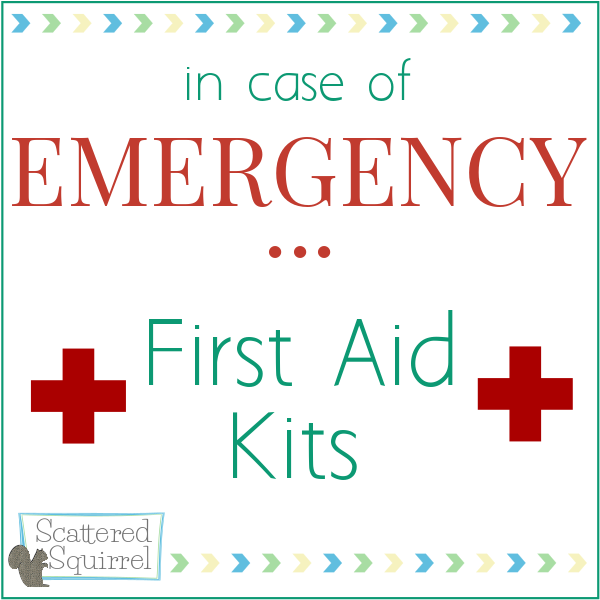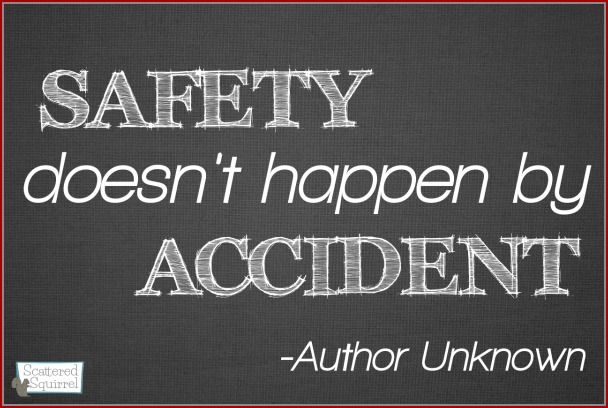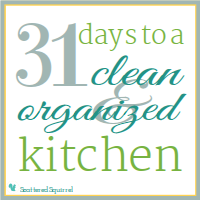Always be Prepared with a First Aid Kit
When most people hear or read the word Emergency Preparedness, they tend to think of being prepared for natural disasters. But there is more to being prepared for an emergency than survival packs and 72 hours kits. The truth of the matter is that most of us are more likely to experience smaller scale emergencies in our homes and our day to day lives than we are to experience a natural disaster. (knock on wood) Many times in our emergency preparations we often overlook the little steps we could be taking to make sure our families are safe and that we’re prepared for those smaller scale emergencies if they crop up. Today I want to take a look at a simple tool that can be a real life saver: The First Aid Kit.

First Aid Kits for the Home
Every home needs at least one first aid kit. I keep a fully stocked one in our downstairs bathroom near the kitchen. It’s not fancy, just a kit we picked up at Wal-Mart a few years ago. I chose one that was small and portable so that when we head out for day trips I can easily toss it into the car or carry it in a backpack. Thankfully, knock on wood, the only things I’ve ever had to to use from it were the tensor bandage, bee-sting, anti-septic and burn relief (I’m a kitchen clutz) wipes and your basic band-aids. I replace and replenish items as we use them, which means that aside from the odd box of band-aids I don’t really have to worry about. It’s a simple step to take to be prepared for an emergency, but I think this is a great place to start in our journey to being more prepared for emergencies.
Now, as I mentioned we just picked up a basic first aid kit from Wal-Mart, which is a great place to start. They come in many different sizes and many different price points so it’s not hard to find one that you can afford. If you would rather go the DIY route, the Canadian Red Cross has a list of items to include in a first aid kit. They include:
- Sterile gauze pads (dressings) in small and large squares to place over wounds
- Adhesive tape
- Roller and triangular bandages to hold dressings in place or to make an arm sling
- Adhesive bandages in assorted sizes
- Scissors
- Tweezers
- Safety pins
- Instant ice packs
- Disposable non-latex gloves, such as surgical or examination gloves
- Antiseptic wipes or soap
- Pencil and pad
- Emergency blanket
- Eye patches
- Thermometer
- Barrier devices, such as a pocket mask or face shield
If you’re going to put together your own First Aid kit, make sure you have something to store your items in. You want to make sure the container you choose to store your first aid kit in is sturdy, portable, and easy to find things in. Some ideas for DIY First Aid Kit containers are:
- Lunch Boxes: These are a great size for smaller first aid kits, and allow them to be really portable
- Tool Boxes: These are great because you can keep smaller, often used items in the top tray and those trays are easy to remove for quick access to the items underneath.
- Craft Caddies: Most craft caddies have lots of compartments, which are great for sorting out all the supplies you need in a first aid kit.
- Plastic bins or baskets: You really can use just a plastic bin or a basket. Reuse tin cans or drawer organizers to help create compartments inside for easy access to all the little bits.
- Old Handbags: Like the craft caddies, these can be a great solution for storing those items.
Once you have a your kit, you need to decide where to store it. A good rule of thumb is to keep it near the kitchen, or the centre of your home. Since many of the injuries that happen at home take place in the kitchen, it makes sense to keep it near there. Other good places to keep them are in the garage or tool shed, or where ever you usually use tools. If you’re an avid DIYer, maybe consider having a couple of kits in different areas so that you’re always prepared. Where ever you decide to keep it make sure it is easy to get to. In case of emergency you don’t want to waste time digging it out. Make sure it’s at the front of a cabinet or drawer, and make sure it’s easily accessible by everyone in your home. If you’re home alone and something happens to you, you might need your 5 year-old to go grab it for you. Once you know where you are going to keep it, show all the members of your family where to find it. It’s also a good idea to show anyone who babysits for you where it is too.
We keep our main first aid kit in the downstairs bathroom. But I also have a partial one upstairs in our room, just in case and another partial one in my purse. We’ve had numerous scraped knees and elbows over the years, and having a few band-aids and some anti-septic wipes on hand has come in pretty handy over the years.
I believe that a basic first aid kit should be a staple item in all homes. Accidents happen. Having the right tools to help deal with them can be a real life saver. After all…

Do you have a first aid kit? If not, why not?




